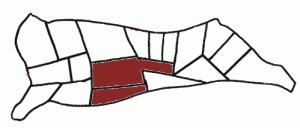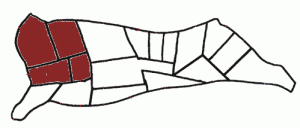Since the time we sold our meat store the little “secrets” we had about those “special” cuts we used to take home for our meals are now common knowledge as you will realize when you read on.
No, owning a meat market does not mean that you get to eat steaks every night, though I must say, as our menu was many times dictated by “what had to go” in the counter and with this steaks and more expensive cuts were often used in our home cooking, even if we had to cut them up and use them for dishes which could be done with cheaper cuts and still be tender and delicious.
“What had to go” are those packages in the meat department marked as “Manager’s Specials”. The cuts which start to loose their color and are not quite red enough to command a full price anymore and nowadays, as everything in the counter has to have an expiration date, it also includes the cuts getting close to be “outdated”.
The expenses to run and operate a meat store or meat department used to be a lot lower, but with increases in rent, utility costs, product cost and even the cost to administer all the new rules and regulations deemed necessary by our government, they went up quite a bit. (I did not include labor cost here as I know from friends, who are not retired yet, that usually with a raise – an increase in productivity is generally expected). This shifted the amount you have to get for each cut of beef from the most tender rib and loin cuts to all the cuts you get out of a side of beef.
Yes, we always had flank steaks, skirt steaks, shanks and short ribs, but those were the “other” cuts from an animal and sold years ago at a lot cheaper price. Nothing changed in the pieces of meat you get from a side, but some cuts formerly used strictly in cube steaks, stew meat and hamburger are nowadays promoted all the way up to the rank of “Steak”.
Let’s start with the skirt steak, which is a thin piece of meat included in the blade. In my early days in the meat business we didn’t think twice to add it to the meat to be ground for hamburger. The popularity of the Tex-Mex cooking made this, when marinated, the favorite cut for Fajitas and this in turn raised the price. The blade also contains bone in and boneless short ribs, which used to be boiled for soups but with proper preparation are now also popular on the BBQ.
The sirloin, the biggest section of the highlighted part in the beef loin picture, used to be cut strictly as a bone in steak, you will have a hard time finding them in any meat counter nowadays.
Then we removed the bone and cut the top part as top sirloin steaks or roast and the round part located below the bone into Filet Mignon. The left over piece of meat on the whole sirloin was strictly used for stew or cube steak but now you will find them merchandised as Tri-Tip roast or steak for greater profitability.
The other major change when cutting a side of beef is in the chuck section.
Round bone roasts and English cuts with bones seem to be a thing of the past and in many cases also the regular bone-in chuck roast. Most of the cuts today are boneless and by taking the bone out, this section of meat is divided into different parts. Here you will find quite a few of the cuts which were promoted to steak status. We include the shoulder top blade steak (flat iron steak) and roast, the ranch steak from the shoulder center and also the shoulder petite tender. If I think back we called the last cut the “Scottie” or “Scotch tender” but this name is probably not political correct anymore as it includes a nationality. This was one of the pieces of meat, when available, often taken home by the butchers.
From Bone-in to boneless cuts:
Why did this come to pass? Live cattle used to be trucked all over the country, to make this more efficient the big slaughter houses were built close to the feed lots. Now you could ship a lot more meat on one truck. So we received our meats as sides of beef with each of them cut in half to get the weight of the pieces below the 180 pound mark for easier handling. When cutting these pieces for the counter you lost about 1/3 of the weight in fat and bones.
So, with the improvements in vacuum packing, the meat cuts were processed at the slaughter house level and the thousands and thousands of pounds of bones and fat did not have to be shipped to the meat stores. Next we went into more and more boneless cuts eliminating the transportation of more of the fat and bones.
A side effect of this is that the time is over when you asked the butcher for an extra bone for your soup or even for your dog to chew on and they just threw one in for free, now the few marrow bones the meat department gets their hands on are sold for a pretty high price and for the big knuckle bones for your dog – you have to go to one of the pet care stores and really shell out some money.
Nowadays the meat department receives everything cut down to a manageable size, usually under 20 pounds per piece, to take it one step further, it is already the trend to cut the meat into individual steaks and roasts at the meat processors and ship vacuum sealed packages which are only priced and placed in the counter at supermarket level eliminating a large part of the meat department.
I always said if we do not watch out and keep producing at work we might be replace by a button, this seems to be the case of your local meat cutter, even if he/she are producing.
Again, see the link in the previous Beef Basics article for a printable chart of the Retail Beef Cuts published by the Cattleman’s Beef Board.



